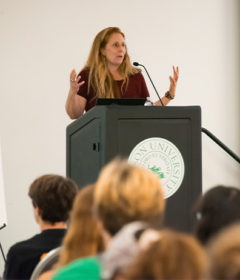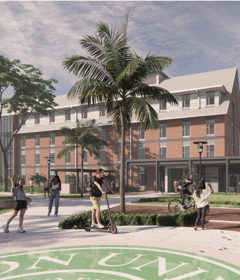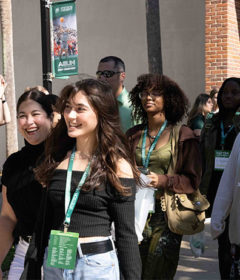2 more buildings earn LEED certification
Stetson University has earned the Leadership in Energy and Environmental Design (LEED) Certification for two more buildings, the Mary B. McMahan Hall and the Homer and Dolly Hand Art Center for a total now of four “green buildings” on the historic campus in DeLand.
In 2003, Stetson’s Lynn Business Center earned LEED certification and became not only Stetson’s first green building on campus, but also the first green building in the state of Florida. Then in 2010, Stetson’s Rinker Environmental Learning Center received LEED certification and became Stetson’s second building to earn the special designation, designed and built according to the LEED standards with programming designed to increase awareness and knowledge about the environment.
“When the LBC was built, LEED was a new concept that we embraced,” said Al Allen, Stetson associate vice president for facilities management. “And we have continued to embrace designing to LEED standards as good stewards of the environment. Environmental responsibility is one of Stetson’s core values, and our new buildings are a reflection of that commitment. We are proud that all of our new buildings are built using environmentally sound standards.”
LEED is an internationally recognized “green building” certification design system developed by the U.S. Green Building Council. LEED includes six primary areas of consideration: sustainable sites selection, water efficiency, energy conservation, materials and resource selection, indoor air quality and innovation in the design process.
Mary B. McMahan Hall is an 8,000-square-foot, one-story music rehearsal hall, which opened in March 2009. It consists of a rehearsal hall and various studios and lecture rooms used by Stetson’s School of Music. The Homer and Dolly Hand Art Center, a 5,000-square-foot building, was dedicated in April 2009 and officially opened to the public in September 2009. It features two galleries: one for displaying works by Stetson faculty and students, and one for displaying selections from the extensive Vera Bluemner Kouba Collection of artworks by Oscar Bluemner (1867-1938), bequeathed to Stetson by the artist’s daughter. Both buildings use low-emitting materials such as adhesives, sealants, and paints; sustainable carpeting and flooring; energy-efficient fluorescent lighting; parking capacity for alternative transportation; and native Florida plant landscape.



